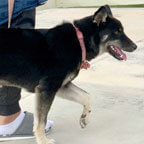A Useful Guide on How to Train Your Dog on a Leash

This guide on how to train your dog on a leash will guide you in the right direction and help you understand some key parts of training your dog how to walk on a leash. Walking your dog on a leash is an essential skill that promotes safety and enjoyable outdoor experiences for both you and your furry companion.
Whether you’re training a new puppy or helping an older dog learn leash manners, proper training techniques can make all the difference. In this guide, we’ll explore step-by-step instructions for training your dog on a leash, ensuring that walks become a pleasant and stress-free activity.
Choose the Right Equipment
Selecting the appropriate equipment is the first step in leash training. Opt for a well-fitting harness or collar that’s comfortable for your dog. Avoid using retractable leashes, as they can encourage pulling and lack control. A standard 4-6-foot leash works best for training purposes.
Start Indoors
Begin your leash training indoors, where there are fewer distractions. Allow your dog to get accustomed to wearing the collar or harness by associating it with positive experiences, such as treats and praise. Attach the leash and let your dog drag it around under supervision to prevent any initial discomfort.
Introduce Loose Leash Walking
Teach your dog the concept of walking on a loose leash by using positive reinforcement. Hold the leash in one hand and offer treats in the other. Start walking, and the moment your dog walks beside you without pulling, reward them with treats and praise. If your dog starts to pull, stop walking and wait for them to come back to your side before continuing.
Practice Attention and Focus
Engage your dog’s attention during walks by using their name and offering treats for eye contact. This helps to redirect their focus to you and encourages them to walk alongside you. Gradually increase the duration of focus before rewarding.
Use Direction Changes
Change directions frequently while walking. This keeps your dog attentive and helps prevent pulling. When your dog pulls, stop abruptly, and change direction. Reward them for following your lead and walking beside you.
Employ Positive Reinforcement
Positive reinforcement is key to successful leash training. Reward your dog with treats, praise, and affection whenever they exhibit desired behaviors. Use treats that your dog finds highly motivating and reserve them specifically for training sessions.
Avoid Punishment
Avoid using punishment-based techniques such as leash corrections, as they can create fear and anxiety in your dog. Leash training should be a positive experience that builds trust between you and your pet.
Practice in Different Environments
Once your dog has mastered loose leash walking indoors, gradually transition to outdoor environments with more distractions. Start in a quiet area and progressively expose your dog to different sounds, smells, and sights. This helps them generalize the behavior of walking calmly on a leash across various settings.
Teach the “Leave It” Command
Teaching your dog the “leave it” command is valuable for preventing them from picking up harmful objects or engaging with other animals. Hold a treat in your closed hand and present it to your dog. When they show interest, close your hand and say “leave it.” Once they stop trying to get the treat, reward them with a different treat and praise.
Manage Excitement
Dogs often become excited when they see other dogs, people, or animals during walks. To prevent pulling and excessive excitement, teach your dog to remain calm when encountering distractions. Use treats and praise to reward calm behavior and engage in training sessions specifically designed to address excitement triggers.
Practice Patience
Leash training takes time and patience. Be consistent in your training sessions and avoid getting frustrated. Celebrate even small successes and remain positive throughout the process.
Gradually Increase Walking Duration
As your dog becomes more comfortable with leash walking, gradually increase the duration of your walks. Start with short walks and slowly extend the time spent outdoors. This helps build your dog’s endurance and reinforces their understanding of proper leash manners.
Include Sniffing Breaks
Allow your dog to enjoy sniffing breaks during walks. Sniffing is a natural behavior for dogs and provides mental stimulation. Give your dog cues, such as “go sniff,” to indicate when it’s appropriate to explore their surroundings.
Consistent Routine
Establish a consistent routine for leash training. Regular walks at the same times each day help your dog anticipate and look forward to their outdoor adventures.
Celebrate Progress
Acknowledge and celebrate your dog’s progress. Whether it’s walking calmly past distractions or responding to your cues, each step forward is a milestone worth celebrating.
We hope our guide on how to train your dog on a leash has been useful!
Leash training is a rewarding endeavor that enhances the bond between you and your dog. With patience, positive reinforcement, and consistent practice, you can teach your dog to walk on a leash with confidence and ease.
Remember that every dog learns at their own pace, so tailor your training approach to suit your dog’s individual needs. By investing time and effort into proper leash training, you’ll pave the way for enjoyable walks and memorable adventures with your four-legged friend.
Contact our trainers today for help with how to train your dog on a leash and let us guide you in the right direction!

